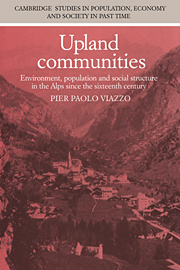 Upland Communities
Upland Communities Book contents
- Frontmatter
- Contents
- List of illustrations
- List of tables
- List of abbreviations
- Acknowledgements
- Introduction: anthropology, historical demography and the study of mountain societies
- 1 Environment, population and social structure: the Alpine village as an ecosystem
- 2 Open systems, open questions
- 3 Anthropologists in the Alps
- 4 The changing demography of Alpine communities
- 5 The traditional economy and its demise
- 6 The causes and consequences of Alpine emigration
- 7 The wealth from the earth: mining and immigration
- 8 Population, resources and homeostatic regulation
- 9 The domestic domain
- 10 Upland communities
- A summary of conclusions
- Bibliography
- Index
A summary of conclusions
Published online by Cambridge University Press: 13 October 2009
- Frontmatter
- Contents
- List of illustrations
- List of tables
- List of abbreviations
- Acknowledgements
- Introduction: anthropology, historical demography and the study of mountain societies
- 1 Environment, population and social structure: the Alpine village as an ecosystem
- 2 Open systems, open questions
- 3 Anthropologists in the Alps
- 4 The changing demography of Alpine communities
- 5 The traditional economy and its demise
- 6 The causes and consequences of Alpine emigration
- 7 The wealth from the earth: mining and immigration
- 8 Population, resources and homeostatic regulation
- 9 The domestic domain
- 10 Upland communities
- A summary of conclusions
- Bibliography
- Index
Summary
In 1980 Alan Macfarlane remarked that it was ‘a pleasing irony that one of the “hardest” of the social sciences, concerned with the analysis of numbers of births, marriages and deaths, should be nudging us towards that realization of the importance of “culture” which, so some have argued, is the special contribution of anthropology’. Recent research in historical demography had in fact demonstrated the existence in pre-industrial Europe of broad regional differences in demographic systems and family structures, and ‘looking from a very long distance’ one could not help being struck by the association between the cultural and ethnic subdivisions of traditional Europe and the demographic map which was gradually emerging. It seemed more than a pure coincidence, to Macfarlane, that the boundary between western and eastern European marriage patterns detected by Hajnal roughly followed the Slav/non-Slav division, and that in Western Europe a demographic frontier separated the southern regions where Roman culture and law were dominant from the Germanic regions to the north.
It is certainly reassuring for anthropology that the findings of historical demographers appear to vindicate the usefulness of the ‘culture area’ approach which Conrad Arensberg had recommended in the early 1960s for the anthropological study of the peoples of the Old World. However, more refined information which has become available in the last few years shows that significant demographic differences existed not only between the major cultural regions of Europe but also within them.
- Type
- Chapter
- Information
- Upland CommunitiesEnvironment, Population and Social Structure in the Alps since the Sixteenth Century, pp. 286 - 296Publisher: Cambridge University PressPrint publication year: 1989
